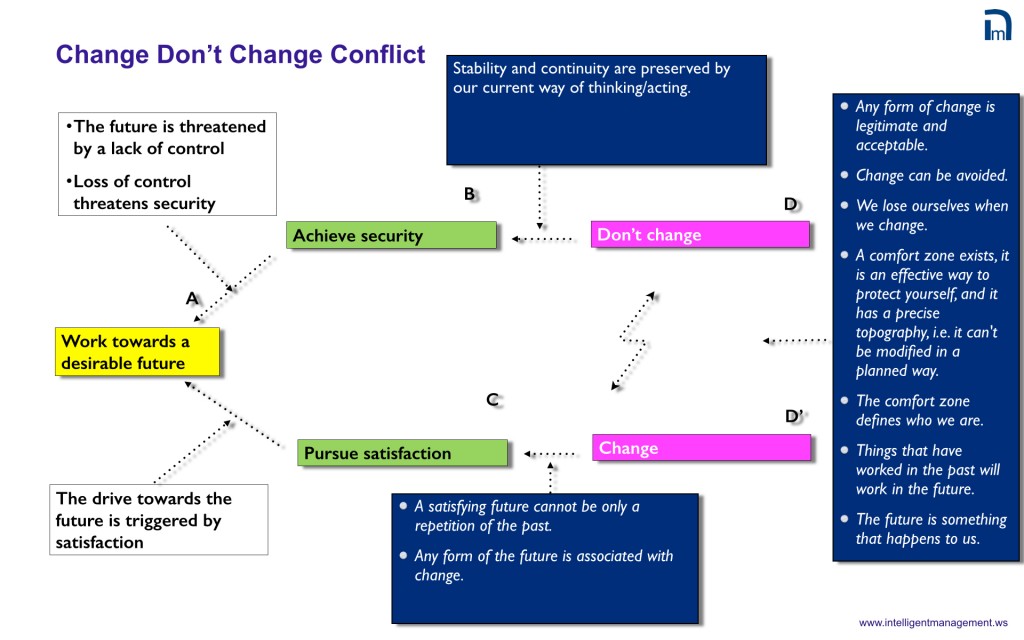 There is a fundamental conflict about change that we all face throughout our lives. If we can verbalize it in a general way, then we have an opportunity to deal with it every time it haunts us.
There is a fundamental conflict about change that we all face throughout our lives. If we can verbalize it in a general way, then we have an opportunity to deal with it every time it haunts us.
If there is one thing we know we will face in life for certain, it’s change. From day to night, from month to month and year to year, our bodies change constantly, and so do our circumstances. The question becomes, how do we cope with it?
Change vs Don’t Change – a paradigmatic conflict
Over the years working with organizations and the individuals that make up the organizations, we have come to mature some paradigmatic considerations about change. We can capture current situations very effectively with a Thinking Process Tool called the Conflict Cloud. Once a situation is captured, like a cognitive snapshot, then we can ask the right questions. We can start digging up all the mental models, assumptions and limiting beliefs that keep us stuck in any given situation. There can be a myriad of situations, but when it comes to change and our resistance to it, we believe, based on our years of work on the field using the Conflict Cloud, that there is a fundamental conflict of change.
The importance of verbalizing a paradigmatic conflict is that it is a very deep conflict that generates many variations, but they all have the same root – the paradigmatic conflict. When we take the time to dig down deep and verbalize this ”root cause”, then we have a pattern that will help us understand many different situations stemming from the same problem. This gives us the advantage of predicting how situations may unfold and a compass to navigate those situations. Here is how we have verbalized the paradigmatic conflict connected with change.
Wants and needs
When we truly want something, it’s because we are trying to protect a legitimate need. Our needs can never be in conflict, but our wants can be.
The need we protect by wanting change
We want change because we want to pursue satisfaction. We all have a driving need for expansion and growth, for achieving more. This need is essentially connected with vision and desire.
The need we protect by NOT wanting change
We don’t want to change because we want to achieve security. This is a need that can be driven by our fears.
Given these two fundamental and legitimate needs that we must protect, what is a goal that satisfies both these needs? We have verbalized that goal as ‘Work towards a desirable future’.
Let’s check the logic of this conflict.
So, if we want to work towards a desirable future, and the future is threatened by a lack of control, and loss of control threatens security (assumptions), then we must Achieve Security (Need). And if we must achieve security, and stability and continuity are preserved by our current way of thinking and acting (assumption) then we DON’T want to change.
On the other hand:
if we want to work towards a desirable future, and the drive towards the future is triggered by satisfaction (assumption), then we must Pursue Satisfaction (Need). And if we must Pursue Satisfaction and a satisfying future cannot only be a repetition of the past, and any form of the future is associated with change (assumption) then we WANT to change.
Why are we stuck in this conflict?
What keeps us stuck between the conflicting positions of change versus don’t change is a set of assumptions, or limiting beliefs. We have listed a few here:
- Any form of change is legitimate and acceptable.
- Change can be avoided.
- We lose ourselves when we change.
- A comfort zone exists, it is an effective way to protect yourself, and it has a precise topography, i.e. it can’t be modified in a planned way.
- The comfort zone defines who we are.
- Things that have worked in the past will work in the future.
- The future is something that happens to us.
We need to recognize that these are merely mental constructs and not facts. We can challenge them. Once we have looked hard at these limiting beliefs, we are free to come up with statements that invalidate them. Those statements will open up a path towards a new reality, where we are no longer limited by what we believe to be true today.
What about you?
When you have read through this conflict, think about situations of change you are facing and see if they also stem from this same, fundamental conflict. If they do, then you have a map to start your journey of thinking about what keeps you stuck. Once you have done that work, then you will have surfaced the assumptions that can lead you to develop a breakthrough solution. All you have to do is challenge your assumptions, finding statements that invalidate them. You’ll have cleared the path to move forward, and you’ll know what to do the next time you get stuck.

Download 2 free chapters of our new business novel ‘the Human Constraint’ here: www.thehumanconstraint.ca





Leave a Reply